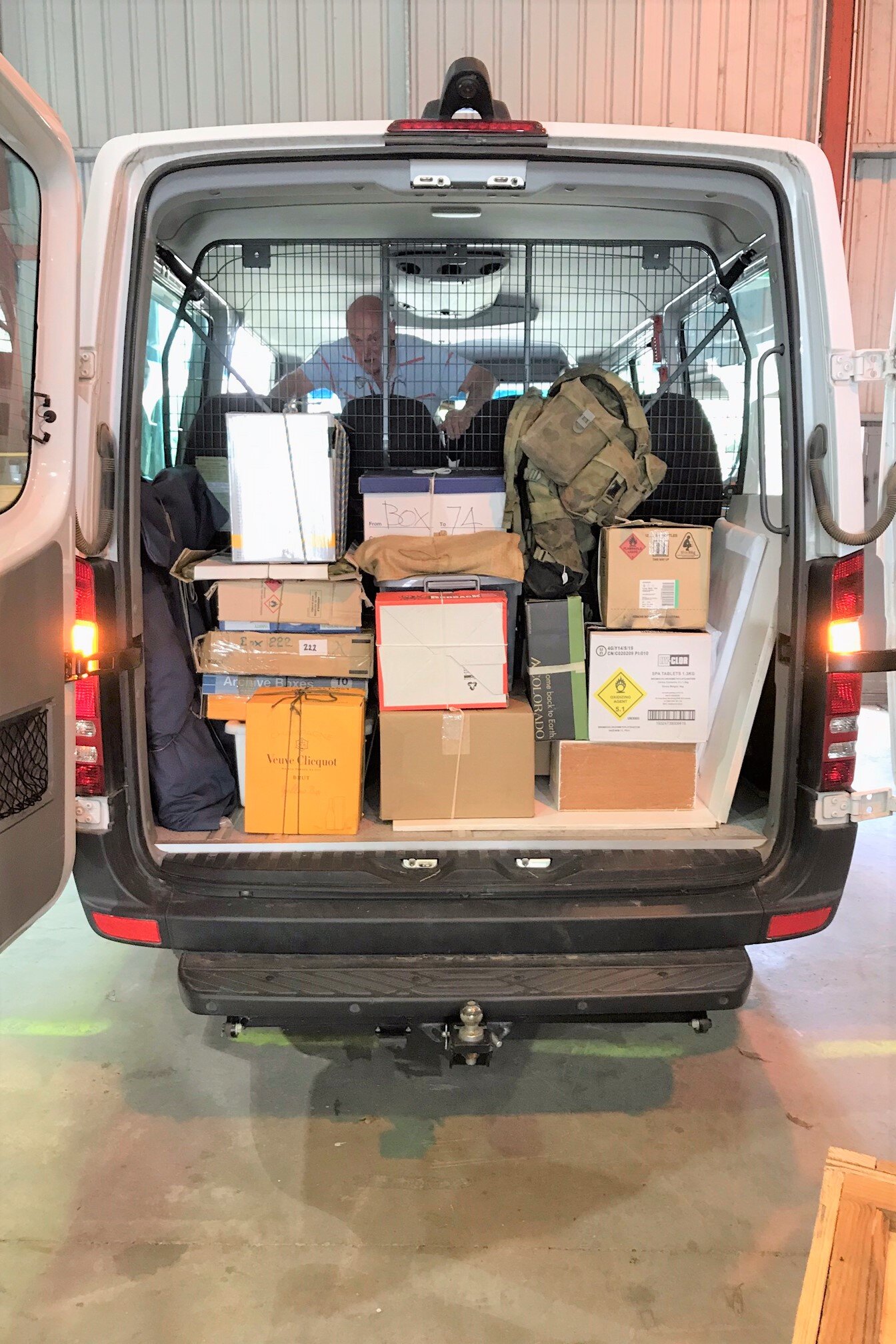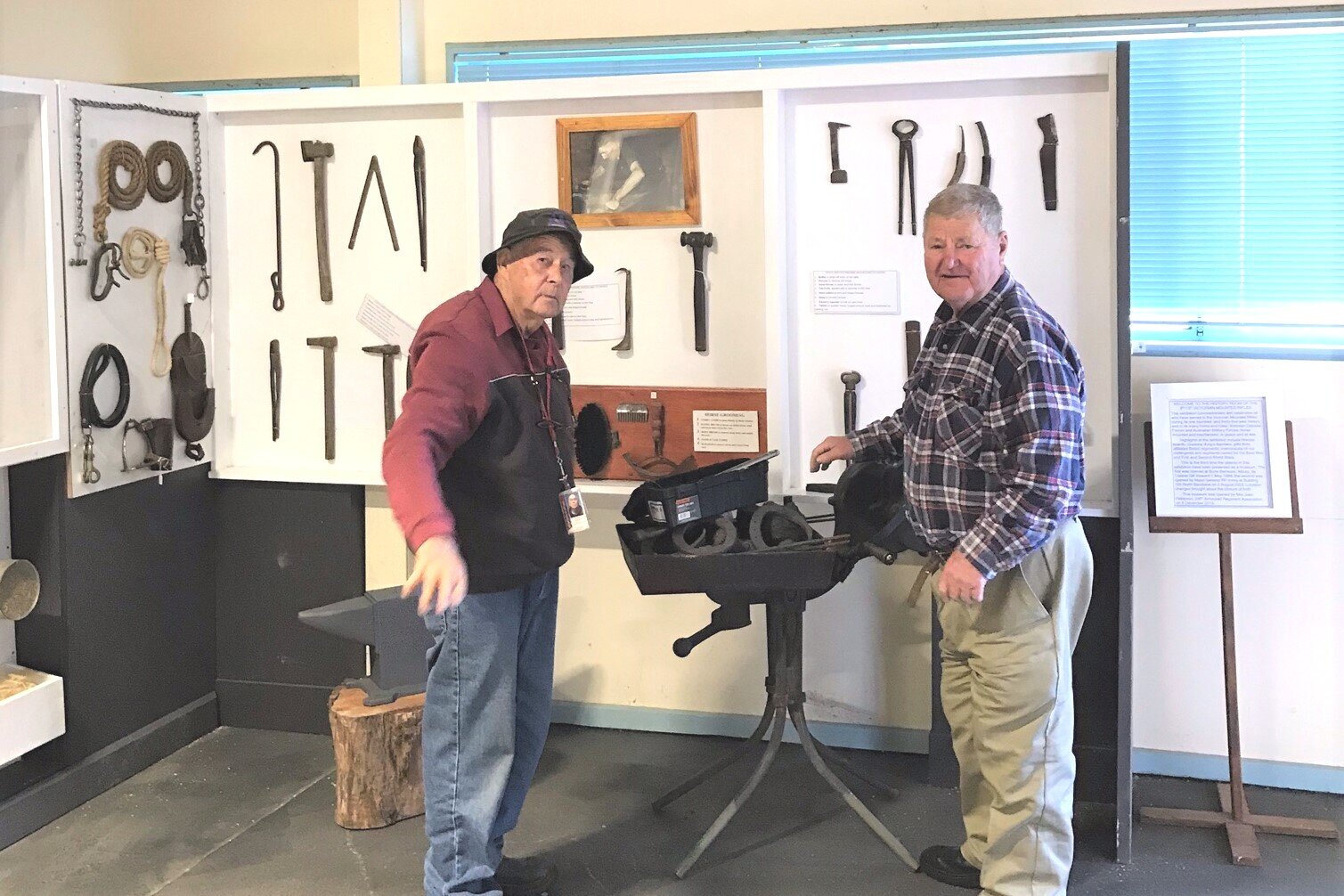FIRST HALF YEAR MUSEUM PROGRESS AT SIMPSON BARRACKS
COVID-19 meant that 2020 was a washout in terms of the Museum team visiting Melbourne and continuing the installation of the exhibition. Work at Bandiana and Latchford Barracks was interrupted by lockdowns and state border restrictions, but it was possible to finish building the new cabinets and prepare for the day when a trip to Simpson was possible. Importantly our team of volunteers remained cheerful, positive and considering our age remarkably healthy.
Museum volunteers who worked throughout 2020 and 2021. The photograph was taken outside Building 129 North Bandiana where the heritage collection has been in storage since it was necessary to vacate the the previous museum location in 2009. From left, standing: Gordon Cole, Graham Garvie, Doug Hunter, Robert Dawe; Seated: Kozzie Carey, Brian Gibson, Maurice Greene.
Museum volunteers Robert Dawe and Kozzie Carey with partly assembled uniform cabinets. Cabinets were constructed of plywood and chipboard. Solid timber facing, rebated to take perspex sheeting, was added later.
Museum volunteers Robert Dawe and Kozzie Carey positioning and fixing farrier’s tools to the display board. Tools were fixed in place with copper wire ties. The workshop where cabinets were constructed or refurbished was at the 4/19 Prince of Wales’s Light Horse depot at Latchford Barracks, Bonegilla.
On a brighter note, the Digitisation team managed the 2020 disruption better than most. It was able to add 300 more entries to our catalogue at Victorian Collections. The team won the award for Excellence in Cataloguing (War Heritage section) for the year. [See previous post]
In early 2021, Melbourne was again open. On 24 February a very welcome team from 4/19 Prince of Wales’s Light Horse Museum came up and took two truckloads of cabinets, objects and archival material to Simpson for us. Our installation team followed with two trailer loads of more stuff and spent two days working industriously on site. The regiment arranged for us to be accommodated at the Barracks and we were able to eat at the Officers’ Mess.
First lift to Simpson for 2021. It had not been possible to visit Melbourne during 2020 owing to measures to control the outbreak of COVID-19. On 24 February, a team of 4/19 Prince of Wales’s Light Horse Light Horse staff and museum volunteers led by 4/19 Museum curator David Key (right) brought two vehicles a truck and a van to Latchford Barracks where loading was done.
The truck took the larger items while the van was stacked full of boxes and tubs containing the display objects both in the passenger compartment and the cargo space at the rear.
In April, a second overnight trip was possible. On this occasion a Thrifty rent-a-truck was hired to transport the remaining cabinets and objects. These included the horse for the light horseman exhibit. Yet even with the truck filled to capacity it was not possible to take everything.
Museum volunteers Robert Dawe and Gordon Cole loading the Thrifty hire truck at Latchford Barracks. The first item to be loaded was our full size horse mannequin. Other objects in the eclectic load included a chest freezer, used to control insect infestation in uniforms, and the steel framing for a storage rack.
At the end of this visit the museum had really taking shape. The uniform cases were filled, the horse and farrier section completed, the double-sided cabinet filled with regimental silver and trophies, and portraits of COs and OCs hung. Our massive archive and photograph collections were on site ready to be placed back into the four-drawer cabinets and the racking in the storage area was assembled.
Uniform cabinet No 2 with three uniformed mannequins in tanksuit c, 1985, Heritage Troop uniform and VMR Squadron trooper on fulltime duty with INTERFET in East Timor. Cabinet is flanked by display of saddle-cloths of 8th, 13th and 20th Light Horse regiments and a Model 1908 cavalry sword as carried by light horse in latter part of WWI and in the 1920-1940 period.
Museum volunteers Graham Garvie and Kozzie Carey assembling the farrier’s forge as part of the display of farrier’s tools. The display highlights the changing role of support services without which the regiment cannot operate. Horse feed has given way to diesel; farriers have become RAEME tradesmen.
Double sided display cabinet containing silverware and trophies relating to light horse regiments of the lineage of 8/13 Victorian Mounted Rifles. The earliest is a trophy presented to the 10th Light Horse (VMR) by The Hon William Pearson MLC, Honorary Colonel, for annual competition by teams of 1 Officer and 13 Men. 17 Oct 1907. Also on display are items of monogrammed crockery made for the 13th Light Horse Officers’ Mess.
Museum volunteers who did the April installation: Gordon Cole, Robert Dawe, Kozzie Carey and Graham Garvie. Fifth member Doug Hunter took the photograph. The horse with the camouflaged cover is still to have its rider mounted.
Another couple of trips are necessary, but COVID-19 restrictions are again making that difficult. Hopefully the situation will improve and there will be opportunities in the last quarter of the year.









